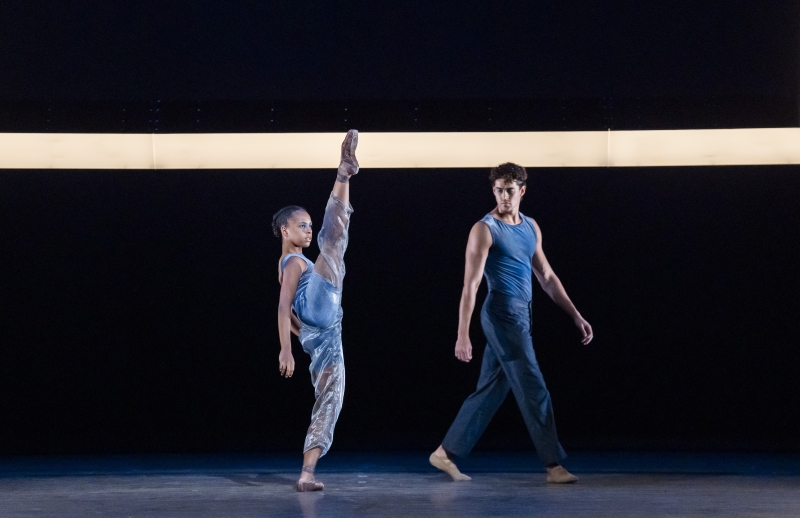Review: ENCOUNTERS: FOUR CONTEMPORARY BALLETS, Royal Ballet And Opera
Asks serious questions about the evolution of ballet

![]() The Royal Ballet season continues with its first modern bill - Encounters: Four contemporary ballets. For some, like me, the four works presented are all new, but in actuality only two of the four are premières. And one of those is, in fact, a development of an existing (2022) pas de deux into a bigger scale work.
The Royal Ballet season continues with its first modern bill - Encounters: Four contemporary ballets. For some, like me, the four works presented are all new, but in actuality only two of the four are premières. And one of those is, in fact, a development of an existing (2022) pas de deux into a bigger scale work.
Opening the programme is Kyle Abraham's The Weathering, first created for the company in 2022. The work is described as an “abstract ballet about remembrance and connection” and though that may be, it doesn't convey so as a clear message. Abraham’s strongest work is for the male dancers. Throughout they communicate interesting readings of masculinity, at times via athletic allegro, at others with sensitive adagio, and all of this language has value and originality. Elsewhere it feels a bit beige, in both look and (noncommittal) content. I've seen other Abraham works that say a lot more.
Following is Or ForeverMore by Pam Tanowitz. This is the developed work, using Dispatch Duet (2022) as its springboard. The original pas de deux was a revelation for me, showing Tanowitz where we've become accustomed to expect her: on THE cutting edge of modern choreography. And Or ForeverMore doesn't disappoint. That said it's not for the faint-hearted as Tanowitz doesn't offer any softness in this work. It's austere setting (black box) and deconstructed purgatory all the way. Zero is predictable, and this feels like a revelation at the ballet where things often follow a tried and tested format.
.jpg)
Photo Credit: Tristram Kenton
The Ted Hearne score is a trip; electric guitar, beat boxing and what sounds like machines in pain. Harriet Jung and Reid Bartelme, Tanowitz’s regular costume design collaborators offer colour block unitards with shoulder pads and Juicy Couture-style tracksuits with a PT insignia - perhaps a direct comment on the monarchy.
There's too much to digest in just one sitting, however Tanowitz confidently reconfirms her status as the queen of spatial tension and patterning. The content also speaks with a determined voice, but one wonders what range could possibly develop with a full length commission. ASAP please.
Post second interval we engage with Dusk by Joseph Toonga. Toonga was the occupant of the Royal Ballet Choreographic Residency for the 2023/24 season and discusses classical ballet and hip-hop fusion within his canon. This is his second work for the mainstage and it's a success. Toonga brings a strong identity to his movement language where dynamic locking is paramount. He also enables the female dancers to move in a way they probably don't get to do very often - creating space for elements of aggression and unapologetic power.
The score by Marina Moore with orchestration by Peter Riley is a world in and of itself; simultaneously classical and modern with nature and city soundscapes piped in from within the auditorium, it's a perpetual feast for the ears. Add to this Simon Bennison’s angular, planetary in nature lighting design and the job's a good ’un. Moving forward, I hope Toonga keeps exploring the possibility of phrasing flow and connecting steps within his burgeoning language.

Photo Credit: Tristram Kenton
Closing the bill is The Statement by Crystal Pite. Created on Nederlands Dance Theater in 2016, and subsequently acquired by the Royal Ballet in 2021, The Statement sees Pite team up with Jonathon Young (text) to create a work looking at the “shadowy depths of human nature and boardroom politics”. Pite and Young first worked together on Betroffenheit in 2015, and The Statement is from a similar, creative fold.
So often in dance one feels the need for words, and here we have them in abundance, but perhaps this actuality reveals a different conundrum. The fact word becomes the soundtrack means the movement has to do far less communicative work, which subsequently causes it to be less interesting.
Pite is popular for obvious reasons, and no one can deny the sophistication of the piece as a whole. The choreographic language is textbook Pite; grounded, lubricated and a bit spooky. The most interesting moments for me were when the movement and text weren't in sync and the dance was able to speak for itself, although I'm aware I'll be in the minority in this opinion.
Frankly speaking this is a worthwhile bill, with a diverse roster of makers, yet it also asks serious questions about the evolution of ballet. Where are the ballet choreographers making new ballets, or rather ballet new? Though we recognise elements of the danse d'école throughout the evening, are we actually seeing classical ballet being reframed like say Balanchine did in the early 20th century, or is the conversation a completely new one more influenced by contemporary dance underpinnings? Is this in fact the new ballet after all…?
Encounters: Four contemporary ballets runs at the Royal Ballet and Opera until 16 November.
Photo credits: Tristram Kenton
Reader Reviews
Videos

